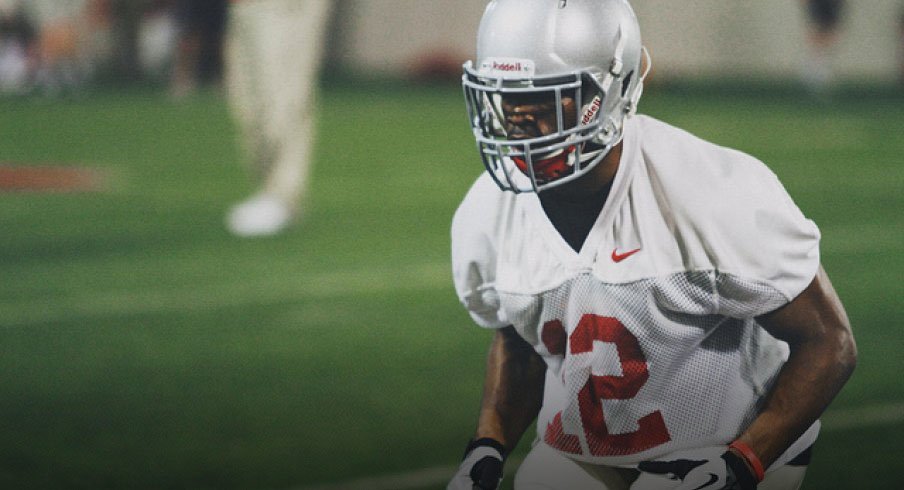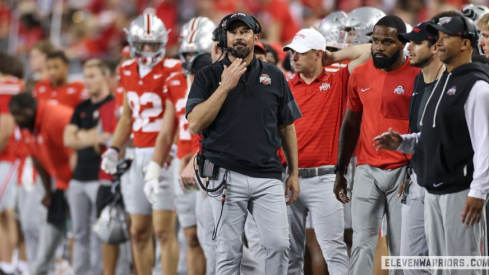Last week we discussed why new Ohio State Defensive Coordinator Chris Ash likes putting his corners in press coverage. Today we look at how Ash trains his defensive backs to play up tight.
Getting Ready to Move
Ash aligns his corners 1-2 yards from the receiver. The corner takes an inside or outside stance – depending where his secondary help is located. The corner gets in an athletic stance. Feet shoulder-width apart, knees flexed and hands up and ready to use.
Ash keys his defenders to watch the receiver's leverage-side hip. The corners are drilled to find a spot and keep their focus on it, as the "key never lies." Problems arise when the corner loses focus or gets sucked in watching the action.
Footwork is Key
After the snap Ash's focus is upon the corner's footwork. Ash stresses the corner cannot lunge at the receiver. Instead, they must be patient and stay square.
Ash wants the corner to force the receiver to release around them. The corner's goal is to keep the receiver in front using quick six inch lateral steps. Ash's biggest coaching point is for the corner to never cross over their feet. The first drill he works on is a mirror drill, where the corner moves laterally mirroring the wide receiver.
When a receiver releases outside the corner's frame Ash's manta is to kickstep. The corner must open their hips at a 45 degree angle and gain depth; again taking pains not to crossover. The corner's goal is to maintain lead position and stay on top of the wide receiver.
At the same time, the corner does not want to open to vertically. That allows the receiver to also get vertical. The 45 degree angle forces the receiver to go around the corner.
After focusing on mirroring and kickbacks, Ash next works footwork with a direction change. When a receiver attempts to work back across the corner's body the defensive back must again flip their hips at a 45 degree angle and not crossover. The corner wants to maintain a good base and force the wide receiver around them.
Ash's footwork drills have a consistent theme. Ash wants his corners to stay on top of the receiver and force the receiver to redirect his route.
It's All in the Hands
Once footwork is established, Ash incorporates the corners' use of their hands. For Ash, the key is for the hands to work in conjunction with the feet. If a receiver tries to release through the corner, Ash teaches the corner to execute a two-hand jam.
The corner punches thumbs up through the shoulder pad breast plate. The goal is to lock out the elbows to create power and maintain separation. The corner should continue to long arm the receiver as he releases up field.
Once a receiver releases outside the corner's set-up the corner executes a one-arm jam. The corner dead arms with the near hand while using the long arm technique with the opposite arm. Critically, the jam must occur with the kick step. As such, Ash repeatedly drills jamming while making the 45 degree drop.
In and Out
Once these fundamentals are mastered, Ash addresses specific techniques for inside and outside releases. This is based upon the knowledge that an inside or outside release signals the type of route being run.
With an outside release, the corner is taught to stay on top of the receiver and hug the receiver's inside hip. From there, the corner's reaction is based upon analyzing the receiver's actions. If the receiver begins to chop his feet, the corner prepares for a comeback route. If the receiver does not break stride, the corner plays a vertical route.
With an inside release, a crossing or post route is more likely, Ash instructs his backs to jam the receiver as he tries to cross the corners' body. Once he gets outside the body they must execute a kickstep and one arm jam. The corner again stays on the receiver's hip, watching his stride to read the route.
This provides a basic overview of Ash's techniques. Ash and his defensive backs repeatedly drill these techniques and work on reading an opponent's patterns. It is this attention to detail that makes playing press coverage possible.


